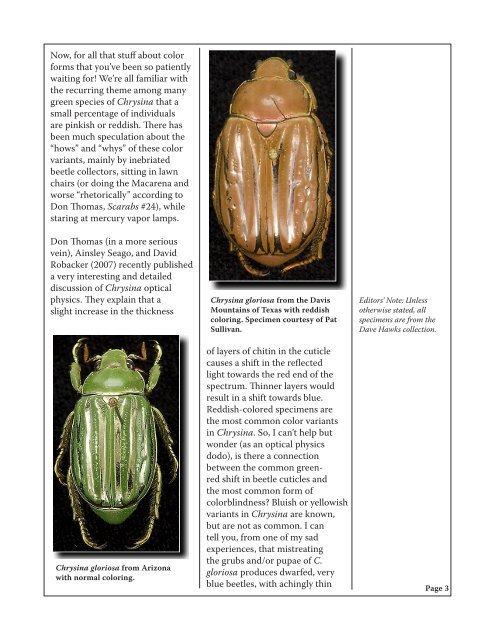SCARABS - University of Nebraska State Museum
SCARABS - University of Nebraska State Museum
SCARABS - University of Nebraska State Museum
Create successful ePaper yourself
Turn your PDF publications into a flip-book with our unique Google optimized e-Paper software.
Now, for all that stuff about color<br />
forms that you’ve been so patiently<br />
waiting for! We’re all familiar with<br />
the recurring theme among many<br />
green species <strong>of</strong> Chrysina that a<br />
small percentage <strong>of</strong> individuals<br />
are pinkish or reddish. There has<br />
been much speculation about the<br />
“hows” and “whys” <strong>of</strong> these color<br />
variants, mainly by inebriated<br />
beetle collectors, sitting in lawn<br />
chairs (or doing the Macarena and<br />
worse “rhetorically” according to<br />
Don Thomas, Scarabs #24), while<br />
staring at mercury vapor lamps.<br />
Don Thomas (in a more serious<br />
vein), Ainsley Seago, and David<br />
Robacker (2007) recently published<br />
a very interesting and detailed<br />
discussion <strong>of</strong> Chrysina optical<br />
physics. They explain that a<br />
slight increase in the thickness<br />
Chrysina gloriosa from Arizona<br />
with normal coloring.<br />
Chrysina gloriosa from the Davis<br />
Mountains <strong>of</strong> Texas with reddish<br />
coloring. Specimen courtesy <strong>of</strong> Pat<br />
Sullivan.<br />
<strong>of</strong> layers <strong>of</strong> chitin in the cuticle<br />
causes a shift in the reflected<br />
light towards the red end <strong>of</strong> the<br />
spectrum. Thinner layers would<br />
result in a shift towards blue.<br />
Reddish-colored specimens are<br />
the most common color variants<br />
in Chrysina. So, I can’t help but<br />
wonder (as an optical physics<br />
dodo), is there a connection<br />
between the common greenred<br />
shift in beetle cuticles and<br />
the most common form <strong>of</strong><br />
colorblindness? Bluish or yellowish<br />
variants in Chrysina are known,<br />
but are not as common. I can<br />
tell you, from one <strong>of</strong> my sad<br />
experiences, that mistreating<br />
the grubs and/or pupae <strong>of</strong> C.<br />
gloriosa produces dwarfed, very<br />
blue beetles, with achingly thin<br />
Editors’ Note: Unless<br />
otherwise stated, all<br />
specimens are from the<br />
Dave Hawks collection.<br />
Page 3
















